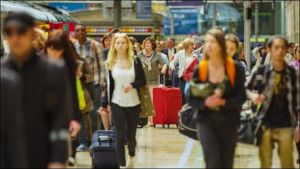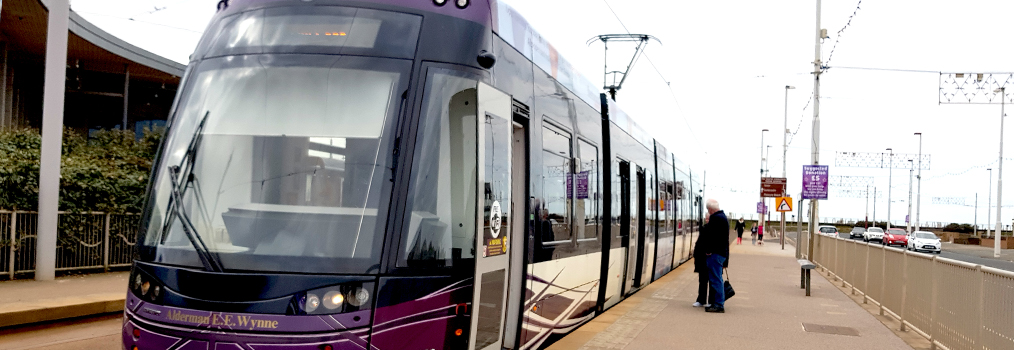Demand recovery slows in spring quarter
Revenue shortfall widens as yields fall and advance tickets boom
 The recovery in demand for rail services in Britain from the Covid pandemic continued into the spring, but the pace of growth slowed with passenger numbers 19.1% higher than the same quarter in 2022, reaching a new post lockdown high. However, rapid growth in numbers using the new Elizabeth Line distorted the figures: growth on the rest of the network was a more modest 10.9%.
The recovery in demand for rail services in Britain from the Covid pandemic continued into the spring, but the pace of growth slowed with passenger numbers 19.1% higher than the same quarter in 2022, reaching a new post lockdown high. However, rapid growth in numbers using the new Elizabeth Line distorted the figures: growth on the rest of the network was a more modest 10.9%.
The recovery in demand for rail services in Britain from the Covid pandemic continued into the spring, but the pace of growth slowed with passenger numbers 19.1% higher than the same quarter in 2022, reaching a new post lockdown high. However, rapid growth in numbers using the new Elizabeth Line distorted the figures: growth on the rest of the network was a more modest 10.9%.
Overall, demand came to within 89.7% of pre-Covid levels, according to National Rail Trends statistics, published by the Office of Rail and Road (ORR). However, without the Elizabeth Line, the recovery is to 80.4%.
The provisional figures cover the first quarter of fiscal year 2023/24, finishing at the end of June: across the network, 390.2m passenger journeys were made during the twelve-week period, up from 305.8m in 2022. Between them, they covered 14.9 billion passenger kilometres, 8.4% up, and paid a total of £2,557m in fares, 19.7% more than in 2022.
Looking at demand by ticket type, advance tickets were up by 18.9%, taking sales 46% higher than before the pandemic. Anytime peak and off-peak fares were up by 22.2% and 21.5% respectively, leaving them 7.8% and 17.2% ahead of the pre-Covid figure. Season ticket holders made 4.9% more journeys than last year, but the 49.4 million total remained 65% below the 2019 figure.
Excluding the Elizabeth Line, services in London and South East moved ahead by 11.7% during the quarter, making it the fastest growing sector. Between them, the operators carried 224.8m passengers in 2023, but remaining 21.9% below 2019. Strongest quarterly growth came at London Overground (14.9%), followed by Greater Anglia (14.3%), GTR (13.1%) and South Western (11.2%). Weakest were South Eastern (5.0%) and West Midlands (8.6%).
The Elizabeth Line carried 51.1 million passengers in its fourth full quarter of operation, having first opened for business in late May 2022. Figures for the line have been revised downwards following discovery of a tendency to overstate passenger numbers in the Lennon data. The revised figures show that the route accounted for 13% of the national network’s patronage in the April to June quarter.
Amongst the regional franchises, total patronage was 10.2% up on 2022 and remained 19.5% below 2019 levels. Amongst individual TOCs, Scotrail saw the strongest recovery, growing passenger numbers by 33.0% during the quarter, though still 29% short of their 2019 figure. Merseyrail saw growth of 7.1% but remained almost 36% short of pre-Covid patronage. TfW saw growth of 1.9% on the quarter but remained 27% short of its 2019 figures. Northern saw a rise of 1.8% in passenger journeys, leaving a shortfall of 21.9%. TransPennine, renationalised during the quarter but still hit by reliability problems as a result of driver shortages, saw modest growth of 1.4% in the quarter, almost 28% short of their 2019 demand.
The long-distance InterCity sector saw demand increase by 8.1% compared with 2022, leaving passenger numbers 8.3% short of 2019 levels. Caledonian Sleeper saw the largest growth, on 12.4%, followed by Avanti West Coast on 10.0%, but still 18.7% short of previous highs. EMR grew by 9.4%, taking passenger numbers 7.7% above pre-pandemic levels. Though LNER saw the lowest growth at 4.2%, the operation still leads the way in recovery, patronage being 10.9% up on the 2018/19 figure.
Amongst the non-franchised operators, Hull Trains saw growth of 30.5% and exceeded their 2019 number by 27.7% whilst Grand Central grew numbers by 11.7% and moved 25.8% ahead of their pre-Covid patronage. Despite the continuing recovery in air travel, Heathrow Express– saw numbers fall by 6% in the quarter, – possibly hit by competition from the Elizabeth Line. This left patronage on the premium route still 21.8% short of previous peaks. Lumo slipped back by 0.5% during the quarter.
Rolling year figures
The national totals for the twelve months ended 31 March show that, compared with the last pre-Covid year of 2018/19, the number of passenger journeys was 17.9% lower at 1,447.4 million. However, excluding the Elizabeth Line, passenger numbers remained 25.4% short of the 2019 figure. Passenger kilometres travelled were 23.4% lower at 51.7 billion, whilst passenger revenue saw a shortfall of 14.6% at £8,848.8 million.
As in previous quarters, performance varied between the sectors. Passenger journeys were still 27.4% below 2019 levels in London and South East and 23.9% on the regional networks but moved to within 15.3% on the InterCity routes.
Comment
By comparison with the huge 80 plus% growth we were reporting on for the same spring quarter twelve months ago, this quarter’s growth seems much less spectacular. However, Elizabeth Line excluded, it was still over ten%: historically high by railway standards. The total carried in the quarter, at 339 million, puts demand at a similar level to 2010 – and I do not recall that number causing any wailing and gnashing of teeth at the time.
However, as I suggested when looking at the last quarter’s figures a few months ago, the real problem lies not in passenger numbers, but in revenue. In real-terms, revenue was £734m down on the same quarter in 2018/19. This translates into a percentage figure of 22.3% – significantly higher than for passenger numbers (10.3%).
Looking at the rolling year, the shortfall in the twelve months to 30 June was £3.6 billion, or 28.3% (compared to patronage shortfall of 17.9%). And all this at a time of accelerating operating costs, so widening the funding gap even further
There are two main reasons for this: below-inflation fares increases and the dramatic shift in the market. Both factors are evident in the lower yields being achieved and the changes in the pattern of ticket purchases.
Looking at yields first, there is a notable decline when the figures are adjusted for inflation. Thus, revenue per passenger kilometre is more than ten% down on the pre-Covid figure – and this rises to over 14% in the InterCity sector, reflecting the loss of first class and business revenue on these routes. On the London and South East commuter routes, the loss of yield is restricted to around four% – probably reflecting the switch away from low-yielding season tickets to more expensive day tickets. The regional routes – already yielding around 30% less per passenger kilometre than either of the other sectors – have seen a post-Covid loss of another eight%.
The other big shift is in the type of tickets purchased by passengers – and here the latest figures also confirm several trends that we have noticed before. First the move towards advance purchase tickets – passengers using these increased by another 18.9% during the quarter, taking the numbers to over 46% higher than pre-Covid. Anytime/peak tickets saw passenger numbers up by 22%, so that sales were 7.8% higher than 2019, whilst off-peak fares were used by 21.5% more people, now 17.2% up on pre-pandemic.
At the same time, there was a small 4.9% increase in the number of passengers travelling with season tickets during the quarter, but the number remained a whopping 65% down on 2019.
The patronage shortfall remains a problem – but recovery is still continuing, and would no doubt be helped by an end to strikes and disruptions caused by staff shortages and overtime bans. We must be wary of overdoing the gloom, though: after all, the network is still all carrying just over double the number of people it did at the time of privatisation. However, the revenue problem presented by the shifts in the market looks much more intractable – especially to a cash-strapped government that is looking for votes amongst commuters next year.



